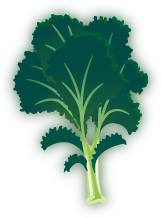GET OUR STAR OF THE WEEK EMAIL subscribe
Fun Facts
Bring a dinosaur home for dinner! We're talking about dinosaur kale, a type of kale with dark green bumpy leaves, also known as Lacinto kale. Kale leaves can also be curly, flat, green, dark red -- even white, purpley or yellow-green. All kale is part of the headless cabbage family and has been around for at least 6,000 years! The ancient Greeks used it to calm upset tummies. Kale is so popular today that there's a National Kale Day in the U.S., and in northern Germany there's an annual kale festival with its very own kale king and queen!
Star Power
Kale has one of the highest levels of antioxidants of any vegetable, with over 45 different flavonoids that put the kibosh on chronic inflammation. Phytonutrients work to keep the liver at its toxin-killing best, and help keep the brain sharp. One cup of kale adds megablasts of vitamins K, A and C. And don't forget iron, folate, omega-3s, magnesium, calcium, iron, fiber and protein! Did you know one serving of kale delivers more absorbable calcium than a small carton of milk?
Quick Preps
PREPARE: Wash kale well, pat dry, then tear the leaves off the stem into bite-size pieces.
- Blend smoothies with kale, banana and blueberries, or kale and mango.
- Chop kale fine and add to pasta, grain bowls and stir-fry.
- Wrap up your favorite protein, like tuna, in a big kale leaf.
- Bake in the oven with a little olive oil and make kale chips.

Fun Tip
Use your kale claw to remove the kale leaves from the spine, then ask your kids if they want to help you squeeze the salad!
Star-Powered Recipe
 Squeezy Kale Salad
Squeezy Kale Salad

Serves 4
Ingredients
- 8 kale leaves, washed, torn off spine
- Sea salt, pinch
Lemon Honey Mustard Dressing
- 2 tbsp. fresh lemon juice
- 3 tbsp. olive oil
- 1 tsp. honey
- 1 tsp. Dijon mustard
- Sea salt and black pepper to taste
Topping Ideas (add your own!) Sliced strawberries, Cucumber chunk, Currant, Nuts/seeds, Goat cheese
Method
- Use your kale claw to tear the leaves off the stem. (Curl thumb in to grab underside of kale spine and bend fingers like a claw around topside of kale spine, then use your kale claw to gently grab the bottom of the kale leaf at the spine and then pull up to remove leaves in one quick motion while pulling with other hand.) Tear the leaves again into smaller pieces. Place in a bowl.
- Add a pinch of sea salt to the bowl, then start squeezing! Squeeze/scrunch release, squeeze/scrunch release big handfuls of kale until the leaves become darker in color and fragrant. Do this for about 1 minute, then drizzle up to 4 tbsp. dressing on the kale and squeeze some more – another 2-3 minutes.
- When the kale leaves are tender, soft and well-coated with dressing, add toppings of choice and enjoy!
How to Store
Fresh, uncooked: Place in a plastic bag and store in the fridge for up to 7 days. To freeze, wash thoroughly and cut off excess stems. Boil for two minutes, then chill with ice cold water. Dry completely, place in an airtight container and freeze for up to a year.
Fresh, cooked:Refrigerate kale within two hours of cooking in a covered container for up to 5 days. To freeze, place in a covered airtight container for up to 12 months.
How It Grows
Kale grows relatively quickly, with strong stems and distinctive leaves reflecting the specific kale variety. Some varieties grow up to 6 feet high, while others hug the ground. Kale plants do really well in cooler weather -- some even become sweeter after a heavy frost.
Peak Seasons
Winter, but available year round
Varieties
Dwarf Siberian, True Siberian, Red Ursa, Redbor, Lacinto, White Russian, Winterbor


 Stars
Stars




